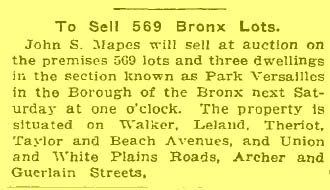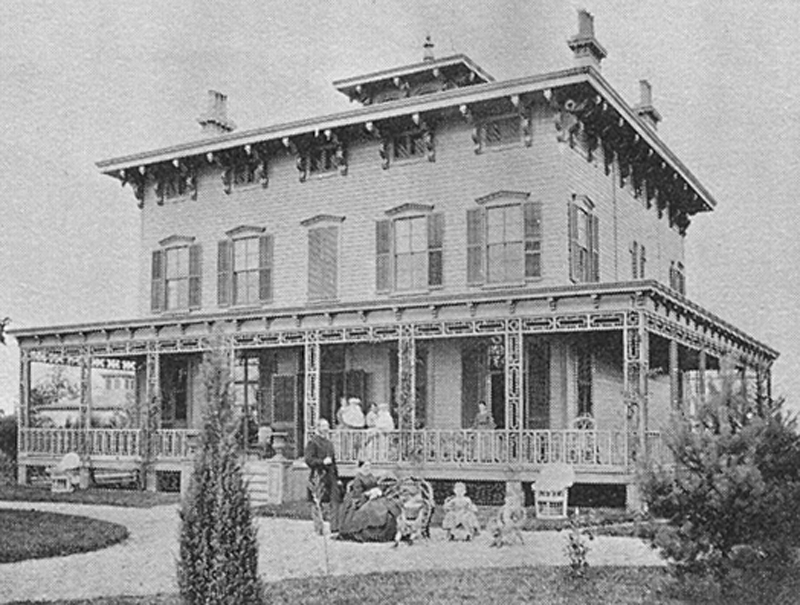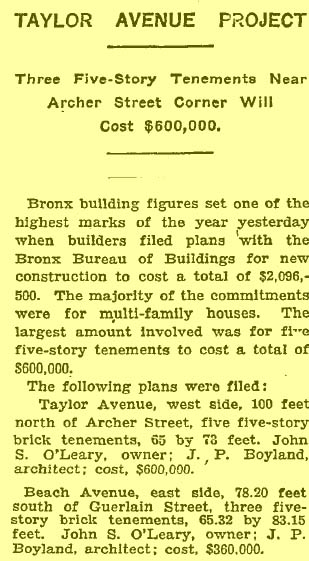 |
| . | DEVELOPMENT OF STRATTON PARK
|
Most of the East Bronx at this time was still the home of the landed gentry. Leonard and Mary Mapes, a wealthy family, built a mansion on what is today Mansion Street. In about 1872 the mansion and grounds were run by John Simonson Mapes, Lenoard and Mary's son who ran a dairy farm on the estate. By 1887, we find John engaged in the real estate business. The NY,NH & H RR made the area ripe for real estate development so alas, the landed gentry would have to land elsewhere. John started selling sold off the estate in 1893. By the time of annexation in 1895 an advertisement appeared in the Westchester Globe for a new real estate development to be called Park Versailles. These new private 1 and 2 family houses were to be built mainly on St. Lawrence, Commonwealth and Rosedale Avenues. Everything from St. Lawrence Avenue to the Catholic Protectory grounds was still a wilderness. |
John S. Mapes continued selling off the family farm. This ad is from September 1913 |

|
GROWTH & TRANSPORTATION
The Park Versailles development grew rapidly, mostly settled by Italian immigrants. The need for a church was answered when St. Anthony's Parish of Van Nest was established by Fr. Devito. Temporary services were held in a rented storefront north of the railroad tracks.
Besides the installation of trolley lines nearby, August Belmont's Interborough Rapid Transit or IRT elevated subway line was scheduled to be passing through the area. Building lots sold quickly. By the mid 1920's, the area east of Park Versailles was sold to an Irish born former policeman turned real estate developer, John Stratton O'Leary.
STRATTON PARK IS BORN
|
|
Between December 1926 and September 1930, John S. O'Leary and his Glengarrif Construction Company broke ground for the O'Leary Flats. The architect for these buildings was a J.P. Boyland.He first buildings were built on the block surrounded by Archer, Taylor, Guerlain and Beach. Later he built his 5-story apartment buildings on the block of Beach, Taylor, Archer and E 177th Street. Later Thieriot Avenue and 1574 Beach would be built. Most of the buildings were 28 family units. Some were more and a few had less. His buildings on Archer Street contained stores so that residents of the area could have some place to shop. There were also some stores built on Beach Ave for additional shopping. He constructed well built, modern apartments containing all the necessities including some luxuries - dumbwaiters to remove garbage, canvass awnings on the windows to keep out the heat of the summer and electrical wiring adequate enough to enable air conditioning to be installed some 70 years before its more modern neighbor to the east, Parkchester. |
STRATTON PARK'S GOLDEN AGE
Stratton Park was a self contained community. With the construction of Parkchester in the late 30's and early 40's, and the additional shopping it would bring, there was really no need to leave the area. Summers could be spent on "tar beach" on the roofs of the O'Leary Flats. Games could be played on the streets. Swimming could be done at nearby Orchard Beach, constructed by Robert Moses or a room or bungalow was always available in Rockaway. For those looking for more entertainment, a movie could be seen at Loew's American or The Palace. Locally, Stratton Park Social Club or one of the many societies & activities at St. Anthony's Church could also pass the time.
At some time after John O'Leary's death in 1942, the O'Leary Flats (or some of them) passed under the control of the Ardea Reality Company, ran by a Richard Dalton. I had assumed that ARDEA stood for "R.D." for Richard Dalton. It was said that Mr. Dalton was the nephew of John S. O'Leary. A writer to this board surmised that Ardea Castle in Ireland may have been the source for the name of this company as this castle was located near John's homeplace in Ireland.
STRATTON PARK (the name)DISAPPEARS
By 1977, the Ardea Reality Company was bankrupt and was was left of the buildings was sold to different owners. The Stratton Park Pharmacy was closed sometime around 1969. There was a Park Stratton Civic Association established in 1968 but it soon ended. The Stratton Park Social Club closed when most of its members moved or died. The Stratton Park Little League moved from its club house on the corner of St.Lawrence Avenue and Merrill Street to the site of Jake's Candy Store, across from St. Anthony's Church. I don't think it is around anymore. The name Stratton Park is hardly used today. Although it would appear that Stratton Park has disappeared from existence, it lives forever in the hearts and minds of all those who were raised there.
Established in 2003, This page is a monument to a little spot in the Bronx called Stratton Park. Once the name of a thriving community, it describes a part of the Bronx situated between White Plains Road to the Bronx River Parkway, East Tremont Avenue and the Cross Bronx Expressway. The neighborhood was named for a real estate developer, John Stratton O'Leary, who starting in 1926 built blocks of apartment buildings that would become the heart of Stratton Park. His buildings were also known un-officially as the O'Leary Flats. The Purpose of this web site is to remember Stratton Park and to pay tribute to John O'Leary and the many others that made it a great place to live, work and play. Please visit our Message Board to see what other have said and perhaps add your own remembrances and facts.
. | . | . | .| .
All Right Reserved © 2003-2014 strattonpark.com

